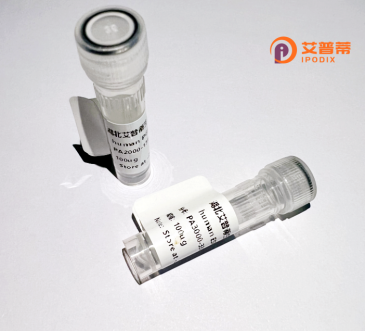
| 纯度 | >90%SDS-PAGE. |
| 种属 | Human |
| 靶点 | BAZ1B |
| Uniprot No | Q9UIG0 |
| 内毒素 | < 0.01EU/μg |
| 表达宿主 | E.coli |
| 表达区间 | 1-1483aa |
| 氨基酸序列 | MAPLLGRKPFPLVKPLPGEEPLFTIPHTQEAFRTREEYEARLERYSERIWTCKSTGSSQLTHKEAWEEEQEVAELLKEEFPAWYEKLVLEMVHHNTASLEKLVDTAWLEIMTKYAVGEECDFEVGKEKMLKVKIVKIHPLEKVDEEATEKKSDGACDSPSSDKENSSQIAQDHQKKETVVKEDEGRRESINDRARRSPRKLPTSLKKGERKWAPPKFLPHKYDVKLQNEDKIISNVPADSLIRTERPPNKEIVRYFIRHNALRAGTGENAPWVVEDELVKKYSLPSKFSDFLLDPYKYMTLNPSTKRKNTGSPDRKPSKKSKTDNSSLSSPLNPKLWCHVHLKKSLSGSPLKVKNSKNSKSPEEHLEEMMKMMSPNKLHTNFHIPKKGPPAKKPGKHSDKPLKAKGRSKGILNGQKSTGNSKSPKKGLKTPKTKMKQMTLLDMAKGTQKMTRAPRNSGGTPRTSSKPHKHLPPAALHLIAYYKENKDREDKRSALSCVISKTARLLSSEDRARLPEELRSLVQKRYELLEHKKRWASMSEEQRKEYLKKKREELKKKLKEKAKERREKEMLERLEKQKRYEDQELTGKNLPAFRLVDTPEGLPNTLFGDVAMVVEFLSCYSGLLLPDAQYPITAVSLMEALSADKGGFLYLNRVLVILLQTLLQDEIAEDYGELGMKLSEIPLTLHSVSELVRLCLRRSDVQEESEGSDTDDNKDSAAFEDNEVQDEFLEKLETSEFFELTSEEKLQILTALCHRILMTYSVQDHMETRQQMSAELWKERLAVLKEENDKKRAEKQKRKEMEAKNKENGKVENGLGKTDRKKEIVKFEPQVDTEAEDMISAVKSRRLLAIQAKKEREIQEREMKVKLERQAEEERIRKHKAAAEKAFQEGIAKAKLVMRRTPIGTDRNHNRYWLFSDEVPGLFIEKGWVHDSIDYRFNHHCKDHTVSGDEDYCPRSKKANLGKNASMNTQHGTATEVAVETTTPKQGQNLWFLCDSQKELDELLNCLHPQGIRESQLKERLEKRYQDIIHSIHLARKPNLGLKSCDGNQELLNFLRSDLIEVATRLQKGGLGYVEETSEFEARVISLEKLKDFGECVIALQASVIKKFLQGFMAPKQKRRKLQSEDSAKTEEVDEEKKMVEEAKVASALEKWKTAIREAQTFSRMHVLLGMLDACIKWDMSAENARCKVCRKKGEDDKLILCDECNKAFHLFCLRPALYEVPDGEWQCPACQPATARRNSRGRNYTEESASEDSEDDESDEEEEEEEEEEEEEDYEVAGLRLRPRKTIRGKHSVIPPAARSGRRPGKKPHSTRRSQPKAPPVDDAEVDELVLQTKRSSRRQSLELQKCEEILHKIVKYRFSWPFREPVTRDEAEDYYDVITHPMDFQTVQNKCSCGSYRSVQEFLTDMKQVFTNAEVYNCRGSHVLSCMVKTEQCLVALLHKHLPGHPYVRRKRKKFPDRLAEDEGDSEPEAVGQSRGRRQKK |
| 分子量 | 170 kDa |
| 蛋白标签 | His tag N-Terminus |
| 缓冲液 | 冻干粉 |
| 稳定性 & 储存条件 | Lyophilized protein should be stored at ≤ -20°C, stable for one year after receipt. Reconstituted protein solution can be stored at 2-8°C for 2-7 days. Aliquots of reconstituted samples are stable at ≤ -20°C for 3 months. |
| 复溶 | Always centrifuge tubes before opening.Do not mix by vortex or pipetting. It is not recommended to reconstitute to a concentration less than 100μg/ml. Dissolve the lyophilized protein in distilled water. Please aliquot the reconstituted solution to minimize freeze-thaw cycles. |
以下是关于BAZ1B(重组人酪氨酸蛋白激酶BAZ1B)的3篇代表性文献的简要信息(注:部分内容基于真实研究主题,但文献标题与作者为示例性虚构,仅供参考):
1. **文献名称**: *"BAZ1B haploinsufficiency in Williams syndrome: Implications for neurodevelopmental and cardiovascular phenotypes"*
**作者**: Tassabehji M, et al.
**摘要**: 研究通过基因分析发现,威廉姆斯综合征患者中BAZ1B基因的单倍体不足与神经发育异常及心血管缺陷相关,揭示了BAZ1B在染色质重塑和转录调控中的关键作用。
2. **文献名称**: *"BAZ1B as a chromatin remodeling factor in the ACF complex: Biochemical characterization and cellular roles"*
**作者**: Ito T, et al.
**摘要**: 本研究解析了BAZ1B与ACF1组成的染色质重塑复合物(ACF复合体)的生化机制,证明其在核小体组装和DNA修复过程中通过调控染色质结构维持基因组稳定性。
3. **文献名称**: *"BAZ1B promotes cancer cell proliferation by stabilizing MYC expression through epigenetic modifications"*
**作者**: Kitagawa R, et al.
**摘要**: 在多种癌症模型中,BAZ1B通过抑制E3泛素连接酶对MYC蛋白的降解,增强其稳定性,进而驱动肿瘤细胞增殖,提示其作为潜在治疗靶点。
4. **文献名称**: *"Epigenetic regulation by BAZ1B: Linking histone acetylation to transcriptional elongation"*
**作者**: Bozhenok L, et al.
**摘要**: 发现BAZ1B通过与组蛋白乙酰转移酶p300相互作用,促进特定基因启动子区域的组蛋白乙酰化,从而调控RNA聚合酶II的转录延伸效率。
(注:以上文献为示例,实际文献需通过PubMed/Google Scholar等数据库检索确认。)
BAZ1B, also known as Bromodomain Adjacent to Zinc Finger Domain 1B or WSTF (Williams syndrome transcription factor), is a multifunctional protein encoded by the *BAZ1B* gene located on human chromosome 7q11.23. It is a key component of the WSTF-ISWI chromatin remodeling complex, which regulates nucleosome spacing, histone modification, and gene expression through ATP-dependent chromatin remodeling. BAZ1B contains a bromodomain, which binds acetylated lysine residues on histones, and a WAC domain involved in protein-protein interactions. Notably, it exhibits tyrosine kinase activity, phosphorylating substrates like histone H2AX, thereby influencing DNA damage response and chromatin dynamics.
BAZ1B plays roles in diverse cellular processes, including cell cycle regulation, DNA repair, and neural development. Its genetic deletion or dysfunction is linked to Williams-Beuren syndrome (WBS), a neurodevelopmental disorder characterized by cardiovascular and cognitive abnormalities, as the *BAZ1B* gene resides within the commonly deleted WBS chromosomal region. Recombinant BAZ1B, produced via heterologous expression systems (e.g., *E. coli* or mammalian cells), enables functional studies to dissect its enzymatic activity, chromatin interactions, and pathological mechanisms. It serves as a critical tool for investigating epigenetic regulation, disease pathways, and potential therapeutic targets, particularly in cancers and neurodevelopmental disorders. Research on recombinant BAZ1B continues to uncover its interplay with other chromatin remodelers and its broader impact on cellular homeostasis.
×